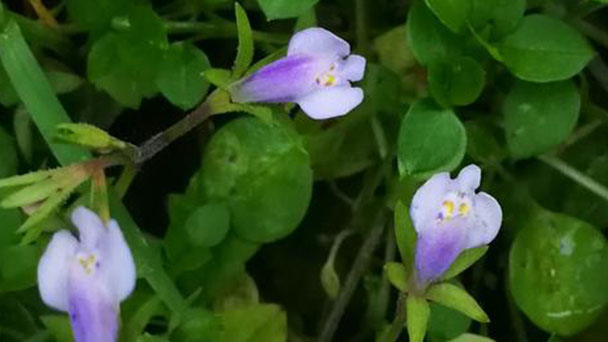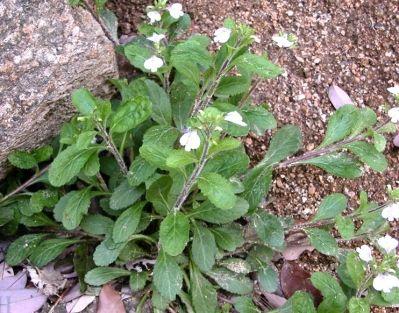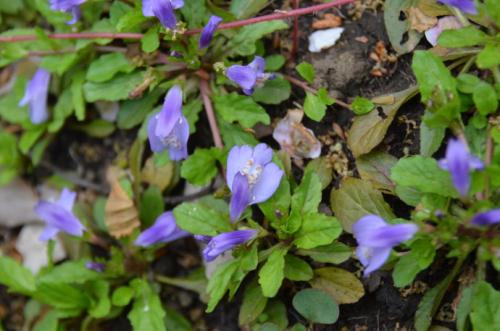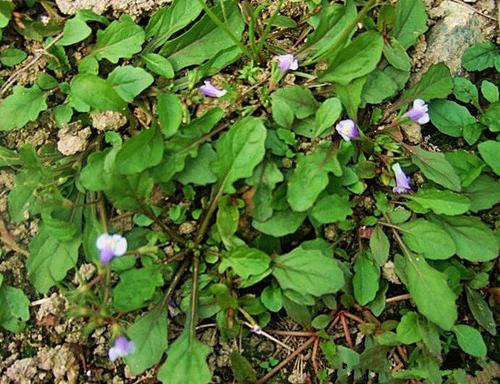Japanese mazus (Mazus pumilus) profile
Written by Maggie
Aug 24 2021

Japanese mazus, scientific name Mazus pumilus, is 3-30 cm tall, glabrous or sparsely pubescent. Racemes born at the top of stems and branches, often near the base of the flowers, elongated or upper fasciculate, usually 3-20, sparse flowers; Calyx is campanulate; Corolla is white, purple, or blue. Capsule is globose; Seeds are small and numerous, yellow.
Japanese Mazus' whole grass can be used to relieve pain, strengthen the stomach, detoxify and reduce swelling.
Japanese Mazus picture

Morphological characteristics of Japanese Mazus
Japanese mazus is an annual, 3-30 cm tall, glabrous or sparsely pubescent. Taproots are elongated, vertically downward or shortening, fibrous roots slender, many, scattered or clustered.
Japanese mazus varies widely in posture, with stems of 1-5 or sometimes more, erect, ascending or decumbent ascending, and often having adventitious roots on the ground nodes. Branches are many and diffuse, but few and unbranched.
Basal leaves of Japanese mazus are few to many, sometimes rosette or caducous, obovate-spatulate to ovate-oblanceolate, membranous to thin papery, 2-6 cm long, apically entire or indistinctly sparsely toothed, basally cuneate, descending into winged petioles, margin irregularly coarsely toothed or base with 1-2 shallow pinnacles; Cauline leaves are opposite or alternate, few, similar to or nearly as large as basal leaves. Racemes born at the top of stems and branches, often near the base of the flowers, elongated or upper fasciculate, usually 3-20, sparse flowers; Pedicels of japanese mazus are as long as 10 mm in fruit, shorter distally; Calyx is campanulate, anthesis ca. 6 mm long, fruit more or less enlarged, sepals subequal to calyx tube, ovate, tip acute, veins inconspicuous; Corolla is white, purple or blue, ca. 10 mm, upper cleft lip ovoid triangular, lower lip middle lobe smaller, slightly protruding, obovate; Ovary of Japanese mazus is glabrous.
Japanese mazus stems 5 -- 30 cm tall, erect or sloping, without stolons, often branching from the base.
Leaves of Japanese mazus are opposite or alternate, obovate to spatulate.2 -- 6 cm long, base cuneate, currently winged petiole, margin irregularly coarsely toothed. Racemes are terminal. Sometimes the stem only gives birth to 1 or 2 leaves namely gives birth to flower; Pedicels fruiting as long as 10 mm, distally shorter; Calyx ca. is 6 mm at anthesis, more or less enlarged at fruIt 'stage; Corolla of Japanese mazus is purple or blue, upper lip short straight, 2-lobed, lobes acute; Lower lip is 3-lobed, medium lobes obovate, flat to calyx tube.
Japanese mazus seeds small and numerous, yellow, seed coat with irregular reticulate.
The ecological habits of Japanese Mazus
Japanese mazus are fond of sunshine and semi-shade, and are often found on wet grassy slopes, along ditches, along roadsides and along forest margins below the elevation of 2,500 meters.
How to grow and care for Japanese mazus
Japanese mazus is a common small weed that grows well with sufficient water and sunlight, and can grow small plants from its roots. Although it is often considered an annual herb, it can survive the winter when potted and even grow for years.
On weekdays, there is no need to move the shearing repair, only to remove the old leaves. If a small section of leaves is left, it will blacken and collapse on the soil surface. Japanese mazus is very unsightly. Removal of leaves can be directly attached to the base of the leaf to pull out, do not use a knife, because its body is very brittle, the knife cut into the dense foliage, often accidentally broke the plant.
How Japanese Mazus propagates
Japanese Mazus can be propagated by sowing or cutting.
Sometimes the seeds drift in and may grow naturally in other pots at home. Because Japanese mazus often grow in large groups, they can also be grown directly from small plants transplanted from the wild.

Classification of Japanese Mazus
1. Stolonifer variety var. wangii(Li)Tsoong
The difference between this variety and its predecessor is that it has obvious short-distance prostrate ascent.Flowers few, 3-7;Plant short;Leaf margin subentire. Produced in southern Yunnan.Growing at 1500-2500 m above sea level in the forest.
2. Japanese mazus var. delavayi(Bonati)Tsoong.
The difference between this variety and the first variety is that the stem is numerous, usually more than 4 branches, and very many branches.Inflorescence elongate, many flowers, 10-20 flowers, pedicels shorter.Yunnan and western sichuan.Raw 1200-2800 meters above sea level of the roadside and wet grassland.It is also found in the eastern part of the Indian peninsula and the western Himalayas.
3. Japanese mazus var. macrocalyx(Bonati)Tsoong
The difference between this variety and the first variety is that the stem is simple and unbranched, and several flowers are born from the base. Calyx approximately more than 1 times larger at fruition, to 20 mm in diameter; Basal derived petioles are longer, often equal to or greater than leaf blade length. Shaanxi, Sichuan, Yunnan, Guangxi, Guangdong and Taiwan. Health 1200-2800 meters above sea level stream, roadside, grassy slope.
4, Japanese Mazus (original variety) var. japonicus
Herbs annual, 3-30 cm tall, glabrous or sparsely pubescent. Taproots elongated, vertically downward or shortening, fibrous roots slender, many, scattered or clustered. The plant has a wide range of body, 1-5 stems or sometimes more, erect, ascending or decumbent ascending, often can grow adventitious roots on the ground part of the node, branching many and scattered, less not branching. Basal leaves few to many, sometimes rosette or caducous, obovate-spatulate to ovate-oblanceolate, membranous to thin papery, 2-6 cm long, apically entire or indistinctly sparsely toothed, basally cuneate, descending into winged petioles, margin irregularly coarsely toothed or base with 1-2 shallow pinnacles; Cauline leaves opposite or alternate, few, similar to or nearly as large as basal leaves. Racemes born at the top of stems and branches, often near the base of the flowers, elongated or upper fasciculate, usually 3-20, sparse flowers; Pedicels as long as 10 mm in fruit, shorter distally; Calyx campanulate, anthesis ca. 6 mm long, fruit more or less enlarged, sepals subequal to calyx tube, ovate, tip acute, veins inconspicuous; Corolla white, purple or blue, ca. 10 mm, upper cleft lip ovoid triangular, lower lip middle lobe smaller, slightly protruding, obovate; Ovary glabrous. Capsule globose; Seeds small and numerous, yellow, seed coat with irregular reticulate.
All over the country, only Inner Mongolia, Ningxia, Qinghai and Xinjiang did not see specimens.Vietnam, USSR, Korea, Japan (Ryukyu), Philippines.Growing below 2500 meters above sea level on wet grassy slopes, ditches, roadside and forest margins.
The distribution of Japanese Mazus
Japanese Mazus are found throughout the country, with no specimens found only in Inner Mongolia, Ningxia, Qinghai and Xinjiang.Vietnam, USSR, Korea, Japan (Ryukyu), Philippines.
Japanese mazus uses
Garden use of Japanese Mazus
Japanese mazus is fond of sunshine and semi-shade, and is often used as a border material for flower beds, as well as green bushes.
Japanese mazus medical uses
Analgesic, stomach-strengthening and detoxifying. Japanese mazus can treat migraine, dyspepsia; Japanese mazus has external treatment of whitlow, impetigo, scald.

Latest Updated
- Benefits of Bugleweed - 7 Science-backed Health Benefits
- Bugleweed Dangers & Side Effects - Is It Poisonous?
- How to Plant Evergreen Trees - What You Should Know
- When to Plant Evergreens - Grow Guide for Evergreen Trees
- 12 Wonderful Evergreen Shrubs for Your Garden
- 12 Popular Evergreen Plants with Pictures for Beginners
- When And How To Prune A Lilac Bush Like a Pro
- How to Grow & Care for Lilac Vine (Hardenbergia Violacea)
- Japanese Lilac Tree (Syringa Reticulata) Care & Propagation Guide
- Shumard Oak Pros and Cons - What to Know
Popular Articles
- Winter maintenance of Antirrhinum Majus
- How to Grow Terminalia Mantaly Tree
- How to Grow and Care for Crossostephium Chinense
- How to grow Antirrhinum Majus in spring
- Peristeria Elata (Dove Orchid) Profile: Info & Care Guide
- Underwatered Snake Plant (Sansevieria Trifasciata) - Signs And How To Fix
- How to Care for Brazilian Jasmine Plant (Mandevilla Sanderi)
- How to Grow & Care for Graptopetalum Purple Delight in Summer
- Rosa Chinensis (China Rose): Plant Growing & Care Tips
- How to Care for Baby Sun Rose (Aptenia Cordifolia)